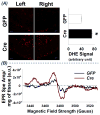Selective Nrf2 Gene Deletion in the Rostral Ventrolateral Medulla Evokes Hypertension and Sympathoexcitation in Mice
- PMID: 28461605
- PMCID: PMC5452971
- DOI: 10.1161/HYPERTENSIONAHA.117.09123
Selective Nrf2 Gene Deletion in the Rostral Ventrolateral Medulla Evokes Hypertension and Sympathoexcitation in Mice
Abstract
Nuclear factor erythroid 2-related factor 2 (Nrf2) is a master transcriptional regulator of redox homeostasis that impacts antioxidant gene expression. Central oxidative stress and reduced antioxidant enzyme expression in the rostral ventrolateral medulla (RVLM) contributed to sympathoexcitation in chronic heart failure. In the current study, we hypothesized that deletion of Nrf2 in the RVLM would increase sympathetic drive and blood pressure. Experiments were performed in Nrf2-floxed mice treated with microinjection of lentiviral-Cre-GFP or lentiviral-GFP into the RVLM. Two weeks after viral administration, Nrf2 message, protein, oxidative stress, cardiovascular function, and sympathetic outflow were evaluated. We found that (1) Nrf2 mRNA and protein in the RVLM were significantly lower in Cre mice compared with control GFP mice. Nrf2-targeted antioxidant enzymes were downregulated, whereas reactive oxygen species were elevated. (2) Blood pressure measurements indicated that Cre mice displayed a significant increase in blood pressure (mean arterial pressure, 123.7±3.8 versus 100.2±2.2 mm Hg; P<0.05, n=6), elevated urinary norepinephrine (NE) concentration (456.4±16.9 versus 356.5±19.9 ng/mL; P<0.05, n=6), and decreased spontaneous baroreflex gain (up sequences, 1.66±0.17 versus 3.61±0.22 ms/mm Hg; P<0.05, n=6; down sequences, 1.89±0.12 versus 2.98±0.19 ms/mm Hg; P<0.05, n=6). (3) Cre mice displayed elevated baseline renal sympathetic nerve activity and impaired inducible baroreflex function. These data suggest that Nrf2 gene deletion in the RVLM elevates blood pressure, increases sympathetic outflow, and impairs baroreflex function potentially by impaired antioxidant enzyme expression.
Keywords: arterial baroreflex; blood pressure; brain stem; oxidative stress; sympathetic regulation.
© 2017 American Heart Association, Inc.
Figures





Comment in
-
Burning Redoxstats in the Brainstem: Lack of Nrf2 and the Rise of Hypertension.Hypertension. 2017 Jun;69(6):1019-1021. doi: 10.1161/HYPERTENSIONAHA.117.09238. Epub 2017 May 1. Hypertension. 2017. PMID: 28461602 Free PMC article. No abstract available.
References
-
- Peterson JR, Sharma RV, Davisson RL. Reactive oxygen species in the neuropathogenesis of hypertension. Curr Hypertens Rep. 2006;8:232–241. - PubMed
-
- Zucker IH. Novel mechanisms of sympathetic regulation in chronic heart failure. Hypertension. 2006;48:1005–1011. - PubMed
-
- Friedman J. Neurology. Humana Press; 2011. Oxidative Stress and Free Radical Damage in.
-
- Dampney RA, Goodchild AK, Tan E. Identification of cardiovascular cell groups in the brain stem. Clin Exp Hypertens A. 1984;6:205–220. - PubMed
MeSH terms
Substances
Grants and funding
LinkOut - more resources
Full Text Sources
Other Literature Sources
Medical
Molecular Biology Databases

